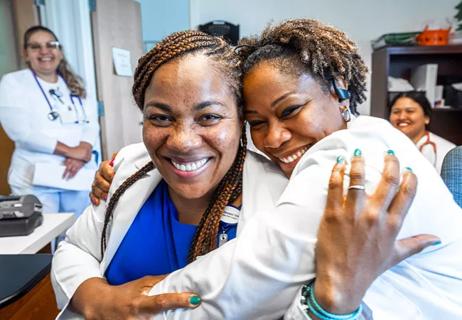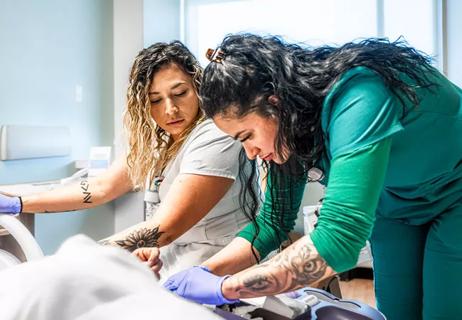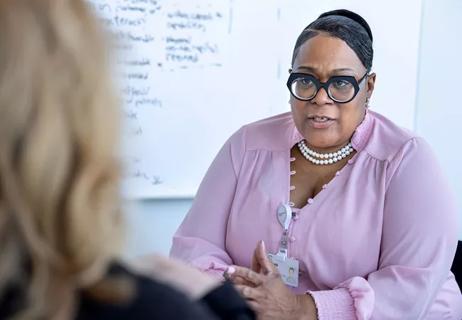A balanced integration of quality, safety and service

Cleveland Clinic will soon be hosting its annual Patient Experience Summit: Empathy + Innovation, which brings together patient experience leaders, healthcare CEOs, nursing leaders, policy makers, industry experts and others who are committed to the patient experience.
Cleveland Clinic is a non-profit academic medical center. Advertising on our site helps support our mission. We do not endorse non-Cleveland Clinic products or services. Policy
Those in attendance will focus on ways to positively impact and strategically evaluate methods and practices for improving patient experience – which many healthcare professionals will agree, can be quite challenging, especially in an environment that is continually evolving.
And for nurses, there is added pressure. Often, because of the nature of the nurse’s role, it is nursing that takes the lead in patient experience.
More than any other caregiver, nursing caregivers have the most interaction with patients. They are on the frontlines. They are with patients around-the-clock. They experience firsthand a patient or family member’s worries, fears, hopes and care goals. They are patients’ best advocates.
Fueled by empathy and compassion, nurses don’t just recognize the need to perfect the patient experience – they encompass the heart-felt desire to make it happen. They see patients as people first – friends, family members and neighbors.
However, nurses in today’s healthcare environment are tasked with more responsibilities than they were in the past. They are required to follow more rigid processes and procedures for patient care. They have electronic charting, hourly rounding, bedside shift reports, patient whiteboards and many other tasks to tend to throughout the day. And, while each task is important, if nurses aren’t able to connect tasks with building patient relationships, the nurse/patient connection can suffer, which is likely to negatively impact patient experience.
To better connect care and experience, nurses need to make sure they are humanizing the care they provide by considering how they:
The old ways of enhancing the patient experience are no longer enough to achieve high performance. For today’s nurses to be successful in both experience and outcomes, there must be a balanced integration of quality, safety and service.
For nurse leaders, that begins with an effective strategy that ensures the right nurses are in the right places, at the right times. Several years ago, with this goal in mind, the Cleveland Clinic Nursing Leadership team worked diligently to better establish foundational pillars for practice that supported a thriving patient experience.
The first priority was to ensure visionary leadership at all levels of the Cleveland Clinic nursing organization. Our leaders worked to refine our approach to practice to consist of care prevention, treatment and management in a way that made patients feel cared for, listened to, respected and safe.
We focused on building a vibrant, positive and strong nursing culture that was not only committed to certain actions and expected behaviors, but that was grounded in evidence-based research and innovation and focused on clear outcomes. We placed special emphasis on professional development. We amplified our efforts to provide ongoing training and education.
And we looked at ways to better create and sustain clear, practical and effective processes for workflow, engagement and action, like standardization and implementing technologies that made nurses’ jobs easier and offered increased opportunity for patient relationship building.
From our patient experience scores to our employee engagement scores, the work began paying off. Patients and family members were writing letters of thanks to our nursing caregiver teams. In one example, a husband whose wife was unexpectedly admitted to a neurology unit at Cleveland Clinic Hillcrest Hospital offered very specific instances of care, safety and service. He wrote that:
Without question, patients are more involved in their care now than they’ve ever been before – and for nursing caregivers, that means every detail matters.
Patients have high expectations. They expect that there is a fully devoted team of caregivers looking out for them. They trust there is a comprehensive care plan in place – from the food they consume to the medication they are administered and the labs that are ordered. They demand their care team members consistently and accurately communicate with one another, properly manage care transitions, and continually focus on their wellbeing. They want to feel empathy and compassion. And they want to know they are safe.
To effectively give patients the experience they deserve, they must be at the center of care delivery and nurse leaders need to ensure a culture of service excellence that elevates the patient experience. As we move forward, we have to learn from the patient experience we provided yesterday and set our sights on the patient experience of tomorrow so we can deliver exceptional care and outcomes and ensure an exceptional patient experience for those we serve.
Be a part of the largest independent patient experience event in the world. Join us for the Patient Experience: Empathy + Innovation Summit May 18-20, 2020, in Cleveland, Ohio.

Cleveland Clinic’s Executive CNO reflects on the image of nursing, aspirations for nurse leaders and more

Researchers reveal factors associated with attrition

Earning a specialty certification, and the right to use its acronym after your name, signifies expertise and a commitment to patient care

Nurse residents gain the skills – and confidence – to care for complex patients

Q&A with Nursing Leaders Katy Perez and Katelyn Papagianis

When potential legal issues arise, it’s best to speak up, ask for help and be transparent

Nurses expand their careers by honing leadership and research skills

As advocates for their patients, nurses need to be empowered to raise concerns about potential issues